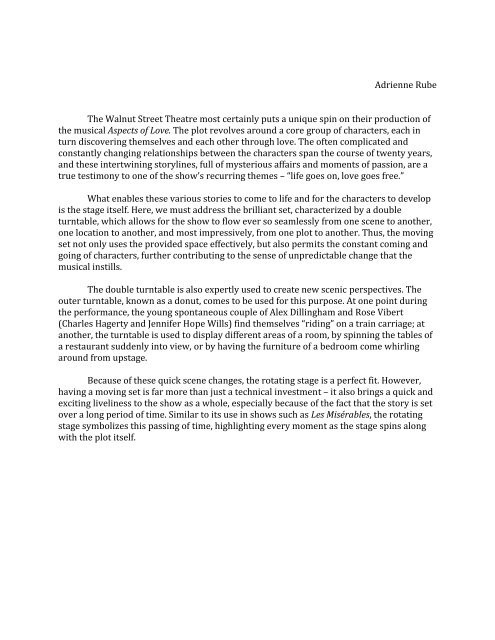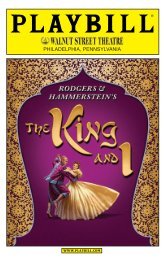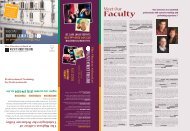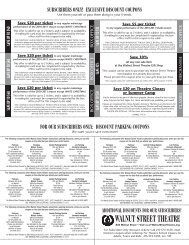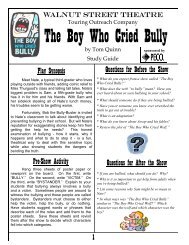Seeing the Stage Through Our Eyes - Walnut Street Theatre
Seeing the Stage Through Our Eyes - Walnut Street Theatre
Seeing the Stage Through Our Eyes - Walnut Street Theatre
Create successful ePaper yourself
Turn your PDF publications into a flip-book with our unique Google optimized e-Paper software.
Adrienne Rube<br />
The <strong>Walnut</strong> <strong>Street</strong> <strong>Theatre</strong> most certainly puts a unique spin on <strong>the</strong>ir production of<br />
<strong>the</strong> musical Aspects of Love. The plot revolves around a core group of characters, each in<br />
turn discovering <strong>the</strong>mselves and each o<strong>the</strong>r through love. The often complicated and<br />
constantly changing relationships between <strong>the</strong> characters span <strong>the</strong> course of twenty years,<br />
and <strong>the</strong>se intertwining storylines, full of mysterious affairs and moments of passion, are a<br />
true testimony to one of <strong>the</strong> show’s recurring <strong>the</strong>mes – “life goes on, love goes free.”<br />
What enables <strong>the</strong>se various stories to come to life and for <strong>the</strong> characters to develop<br />
is <strong>the</strong> stage itself. Here, we must address <strong>the</strong> brilliant set, characterized by a double<br />
turntable, which allows for <strong>the</strong> show to flow ever so seamlessly from one scene to ano<strong>the</strong>r,<br />
one location to ano<strong>the</strong>r, and most impressively, from one plot to ano<strong>the</strong>r. Thus, <strong>the</strong> moving<br />
set not only uses <strong>the</strong> provided space effectively, but also permits <strong>the</strong> constant coming and<br />
going of characters, fur<strong>the</strong>r contributing to <strong>the</strong> sense of unpredictable change that <strong>the</strong><br />
musical instills.<br />
The double turntable is also expertly used to create new scenic perspectives. The<br />
outer turntable, known as a donut, comes to be used for this purpose. At one point during<br />
<strong>the</strong> performance, <strong>the</strong> young spontaneous couple of Alex Dillingham and Rose Vibert<br />
(Charles Hagerty and Jennifer Hope Wills) find <strong>the</strong>mselves “riding” on a train carriage; at<br />
ano<strong>the</strong>r, <strong>the</strong> turntable is used to display different areas of a room, by spinning <strong>the</strong> tables of<br />
a restaurant suddenly into view, or by having <strong>the</strong> furniture of a bedroom come whirling<br />
around from upstage.<br />
Because of <strong>the</strong>se quick scene changes, <strong>the</strong> rotating stage is a perfect fit. However,<br />
having a moving set is far more than just a technical investment – it also brings a quick and<br />
exciting liveliness to <strong>the</strong> show as a whole, especially because of <strong>the</strong> fact that <strong>the</strong> story is set<br />
over a long period of time. Similar to its use in shows such as Les Misérables, <strong>the</strong> rotating<br />
stage symbolizes this passing of time, highlighting every moment as <strong>the</strong> stage spins along<br />
with <strong>the</strong> plot itself.


